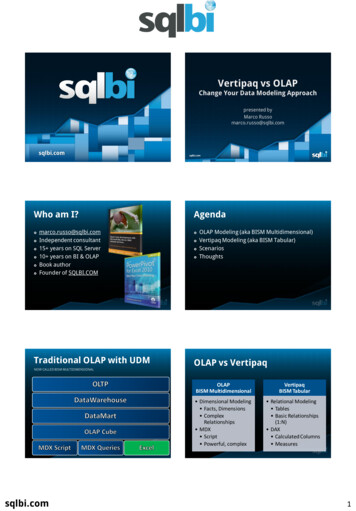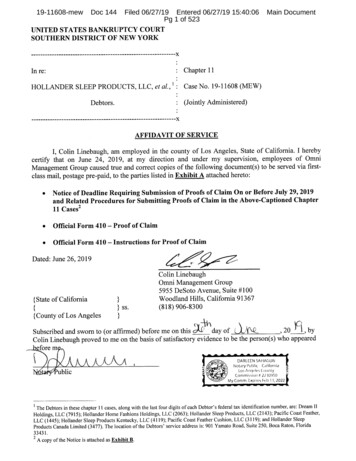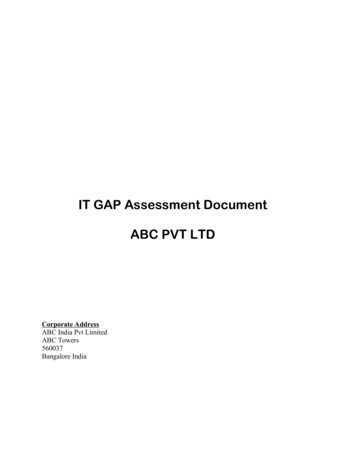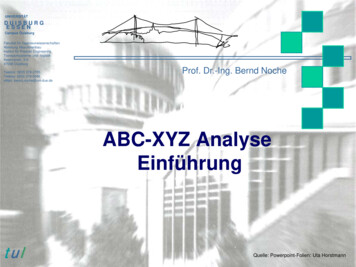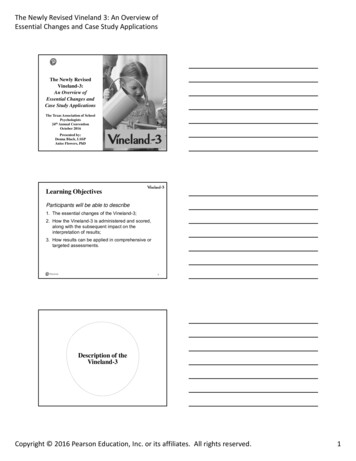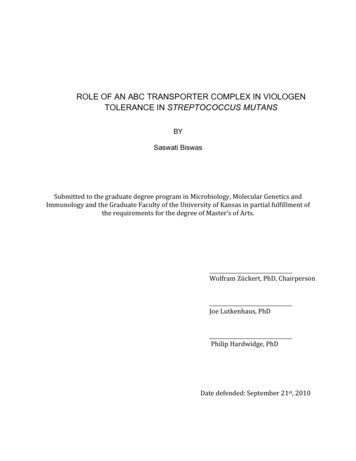
Transcription
ROLE OF AN ABC TRANSPORTER COMPLEX IN VIOLOGENTOLERANCE IN STREPTOCOCCUS MUTANSBYSaswati BiswasSubmitted to the graduate degree program in Microbiology, Molecular Genetics andImmunology and the Graduate Faculty of the University of Kansas in partial fulfillment ofthe requirements for the degree of Master’s of Arts.Wolfram Zückert, PhD, ChairpersonJoe Lutkenhaus, PhDPhilip Hardwidge, PhDDate defended: September 21st, 2010
The Thesis Committee for Saswati Biswas certifiesthat this is the approved Version of the following thesis:ROLE OF AN ABC TRANSPORTER IN VIOLOGEN TOLERANCEIN STREPTOCOCCUS MUTANSCommittee:Dr. Wolfram Zückert, ChairpersonDr. Joe LutkenhausDr. Philip HardwidgeDate approved:ii
ABSTRACTThe gram-positive bacterium Streptococcus mutans is the primary causative agent in theformation of dental caries in humans.To persist in the oral cavity, S. mutans must be able totolerate rapid and substantial environmental fluctuations and exposure to various toxicchemicals. However, the mechanisms underlying the ability of this cariogenic pathogen tosurvive and proliferate under harsh environmental conditions remain largely unknown.In thecurrent study we wanted to understand the mechanisms by which S. mutans withstandexposure to various quaternary ammonium compounds (QAC) such as methyl viologen (MV)that also generates superoxide radicals in the cell. To elucidate the genes that are essential forMV tolerance, sensitive mutants of S. mutans were generated via ISS1 mutagenesis. Screeningof approximately 3,500 mutants revealed fifteen MV sensitive mutants. Among them, five andfour independent insertions had occurred in SMU.905 and SMU.906, respectively. These twogenes are organized in an operon and encode a putative ABC-transporter complex.LinkagePCR analysis supports the operon organization of these two genes and also indicates that thetranscription start site maps further upstream of SMU.905.To confirm our results, SMU.905was deleted using an antibiotic resistance marker; the SMU.905 deletion mutant was just assensitive to MV as the ISS1 insertion mutants. Furthermore, SMU.905 and SMU.906 mutantswere sensitive to other viologen compounds such as benzyl- and ethyl- viologen. Sensitivity tovarious drugs including a wide range of QACs was tested. It appears that a functional SMU.905is also required for full resistance towards acriflavin, ethidium bromide, and safranin; all are wellknown QAC. These results indicate that SMU.905/SMU.906 probably constitute a heterodimericmultidrug efflux pump of the ABC family. BLAST-P analysis suggests that this ABC-type effluxpump is widely present in streptococci, enterococci, and clostridia including some importanthuman pathogens.iii
ACKNOWLEDGMENTSI extend my sincere thanks to Dr. Wolf Zückert for his willingness to serve as a researchsupervisor and his expert guidance about the research project as well as his kind supportthroughout the course of this study.I am grateful to the members of my thesis committee, Dr. Joe Lutkenhaus and Dr. PhilHardwidge, for their invaluable critiques and insightful comments about the project.I would like to thank Dr. Michael Parmely for kindly accepting me as a transfer student into theDepartmental Graduate program and for his continuous support.I also take this opportunity to thank Dr. Robin Miskimins, University of South Dakota, whointroduced me to the wonderful field of Biochemistry and Molecular Biology, which encouragedme to join the Biomedical Graduate Program at the USD.Thank you also to the members of the Biswas lab. Your friendship and support has been muchappreciated.Beyond the lab, I would like to thank my friends for putting up with my moments of “intensity”,and always listening when I needed it.Finally, I thank my family for their constant support especially when I took time-off from being afulltime mother and wife to fulfill my goal.iv
TABLE OF CONTENTSABSTRACT .iiAcknowledgments .iiiTable of Contents .ivList of Tables .viList of Figures .viiList of Appendix . .viiiList of Abbreviations .ixChapter 1 INTRODUCTION -------------------11.1. Oral microbial community -----------11.2. Diseases caused by S. mutans -----51.2.a Dental -----------------------------51.2.b Infective Endocarditis -------------61.3 Important Virulence Traits of S. mutans ------------------------------------------71.3.a. Adhesion ----------------------------81.3.b. Biofilm Formation -------------------91.3.c. ------------------------------------121.3.d. Acid Tolerance ---------------------121.3.d. Production of Mutacin ------------141.4 Genomic organization & diversity among S. mutans clinical isolates ---151.5 Multidrug Resistance in Bacteria --191.6. Scope of the Study ---------------------21Chapter 2 MATERIALS AND METHODS ----222.1. Bacterial Strains and Growth Conditions ----------------------------------------222.2. Transposon Assay and Screening 22.3. Identification of ISS1 integration site .4. Curing of pGhost9::ISS1 from the selected mutants-----------------------312.5. Construction of SMU.905 deletion mutant ----------------------------------------312.6. Isolation of RNA from Bacterial -332.7. Semiquantitative ----------------332.8. Linkage RT-PCR Analysis -----------372.9. Sensitivity to Various Reactive Oxygen Species -------------------------------37v
2.10. Antibiotic Susceptibility Assay -----382.11. Acid Stress ---------------------------2.12. Sensitivity to Osmotic ------------402.13. Sensitivity to other Chemical Stresses 14. SOD Activity ---------------------------2.15. Biofilm Formation -----------------2.16. Phenotypic Microarray --------------------------------------------443.1. Isolation of S. mutans UA159 Methyl Viologen Sensitive Mutants -------443.2. Mapping ISS1 Insertion sites on the Chromosome of MV -------------------453.3. Characterization of the SMU.905 and SMU.906 loci---------------------------463.4. SMU.905 is Involved in Viologen Tolerance --------------------------------------473.5. SMU.905 - SMU.906 Loci are Widely Present in S. mutans Strains ------503.6. SMU.905/SMU.906 is not Involved in Biofilm Formation ---------------------513.7. SMU.905/SMU.906 is not Involved in Superoxide or Oxidative Stress --513.8. SMU.905/SMU.906 is only Required for Tolerance to Dipyridyl-----------543.9. SMU.905/SMU.906 is also Crucial for Tolerance to Some QACs ----------613.10. Participation of SMU.905/SMU.906 in Antibacterial Tolerance -----------423.11. Phenotypic Microarray Analysis of IBSA26 -------------------------------------653.12. Role of SMU.902 in Viologen Tolerance r 4 DISCUSSION ---------------------------82Chapter 5 REFERENCES -------------------------82Chapter 3 ------101vi
LIST OF TABLESTable 1: Genomic content comparison of two S. mutans strains -------------------18Table 2: List of primers used in this study 26Table 3: List of bacterial strains and plasmids e 4: ISS1 flanking integration sequences e 5: Sensitivity to various chemicals -48Table 6: Sensitivity to diquat ------------------59vii
LIST OF FIGURESFigure 1: Schematic diagram of the mechanism of integration of ISS1 ----------------------25Figure 2: General strategy to isolate viologen sensitive mutants -------------------------------29Figure 3: Southern blot analysis of the mutants --32Figure 4: Strategies used for identification of ISS1 insertion sites ----------------------------35Figure 5: Schematic diagram of generating plasmid cured ISS1 mutant strains -----------39Figure 6: Organization of the SMU.905/SMU.906 loci in S. mutans ---------------------------49Figure 7: Linage analysis of the SMU.905/SMU.906 loci -----------------------------------------52Figure 8: Verification of viologen-sensitive phenotype ure 9: Biofilm formation by UA159 and IBSA26 Figure 10: SOD activity in S. mutans ----------------55Figure 11: Disk diffusion assay to measure the MV susceptibility----------------------------58Figure 12: SMU.905 expression is not induced by MV treatment -------------------------------60Figure 13: Susceptibility of S. mutans to QAC by disk diffusion assay ------------------------62Figure 14: Sensitivity to various biological dyes related to QAC------------------------------63Figure 15: PM analysis for sensitivity to various antibiotics and toxic compounds ---------67Figure 16: Verification of SMU.902 mutants to methy viologen sensitivity -------------------68Figure 17 A: Multiple sequence alignment of SMU.905 and its closest homologs ---------77Figure 17 B: Multiple sequence alignment of SMU.906 and its closest homologs ---------78viii
LIST OF APPENDICESTable S1. Sensitivity to various --------------------102Table S2. Various ABC-type transporters in S. mutans UA159----------------------------------104ix
ABBREVIATIONSABCATP binding cassetteAFAcriflavinBPBase pairsCRISPRClustered regularly interspaced short palindromic repeatEmErythromycinGASGroup A streptococcusGBSGroup B streptococcusIEInfective endocarditisISInsertion sequenceKmKanamycinLBLuria-BertiniMDRMultidrug resistanceMICMinimum inhibitory concentrationMVMethyl viologenODOptical densityORFOpen reading framePMFProton motive forceQACQuaternary ammonium compoundsRGPRhamnose-glucose polysaccharideRT-PCRReverse transcriptase polymerase chain reactionSmSpectinomycinSMU.Designation for ORFs of S. mutansTHYTodd-Hewitt with yeast extract brothTsThermosensitivex
CHAPTER 1INTRODUCTION1
1.1. Oral microbial communityDental plaque is a complex biofilm, which contains diverse bacterial species that are adhered totooth or other oral tissue surfaces and are embedded in a matrix composed of extracellular DNAor polysaccharides (133, 134). The oral cavity is a dynamic environment that undergoes rapidand substantial changes in pH, nutrient availability, oxygen tension, osmotic stress, andtemperature fluctuations (17, 113, 114). The amount of toxic substances that often come fromoral care products is also in constant flux in the oral cavity. Despite these harsh environments,over 600 microbial species have been estimated to colonize the oral cavity as complexpopulations in biofilms (156). About 20% of the oral microorganisms are streptococcal speciesthat are associated with oral health as well as various diseases (99).Oral bacteria often exhibit distinct tissue-specific tropisms and many of these organisms havebeen found to colonize different surfaces of the oral cavity, such as the tooth enamel, tongue,and other bacterial lawn (126). Studies focused on examining which species preferentiallycolonize a particular biological surface in the oral cavity have shown that hard tissue surfaces,such as the teeth, are preferentially colonized by Actinomyces species. On the other hand,Prevotella melaninogenica and Veillonella parvula colonize soft tissue surfaces in higherproportions (126).Furthermore, streptococcal species, such as S.mitis, S. oralis, and S.salivarius predominantly colonize the soft tissues and are also found in higher proportion in thesaliva compared to other organisms (154).However, gram-negative bacteria such asCapnocytophaga gingivalis and V. parvula primarily colonize the tongue, which is also a softtissue (126).Since particular species tend to dominate in specific regions of the oral cavity, itsuggests that organisms express different cell-surface associated proteins such as adhesinsthat determine the environmental niche or tissue tropism (126).2
The dental plaque initiates with so-called “pioneer” organisms, or early colonizers, which adhereto host salivary components on the tooth enamel (100, 205).Among the early colonizers,about 60-80% are streptococcal species belonging to the viridians group, including S. mitis, S.oralis and S. sanguinis, and these streptococci form relatively simple biofilm communities (98,101, 205). Following early colonization, the biofilm microflora becomes more complex as aresult of co-aggregation between different bacterial species (98). Adhesins on one species maybe capable of recognizing a cell-surface receptor on another organism, thereby allowingdiversification of the biofilm community (101). These cell-cell interactions have been extensivelystudied and various adhesins that promote co-aggregation have been identified. For example,the SsaB protein of S. sanguinis mediates co-aggregation with Actinomyces naeslundii andStreptococcus gordonii (101). Furthermore, co-aggregation of A. naeslundii with variousstreptococcal species, including S. gordonii, S. oralis, S. mitis and S. sanguinis, is thought to bemediated by type-II fimbriae on A. naeslundii and receptor polysaccharides on the streptococcalspecies (150, 205). Fusobacteria, on the other hand, are able to co-aggregate with both theearly colonizers as well as later colonizers, such as Actinobacillus and Treponema species,thereby serving as a connector between early and late colonizers (98, 100). These cell-cellinteractions lead to the formation of more diverse biofilm involving hundreds of microbialspecies. As the biofilm matures, more complex interactions begin to occur involving cooperationand competition among various plaque microflora.A typical characteristic of the community lifestyle of dental plaque is recycling of metabolicbyproducts among various bacterial species.The metabolic byproducts of one organism canbe potentially used as a source of nutrition by another organism and complex metabolicnetworks are generated within the biofilm community (105). For example, lactic acid producedby Streptococcus mutans can be utilized as an energy source by Veillonella species andStreptococcus oligofermentans (28, 105).Furthermore, a symbiotic interaction between S.3
oralis and A. naeslundii was observed, when nutrient-limited saliva was provided as the soleenergy source in a mixed-species biofilm (153).However, when cultivated independentlyneither of these two could survive. It was only when these two species were grown together thatthey were able to flourish in the biofilm. A surprising finding is that during anaerobic growth S.mutans requires para-aminobenzoic acid, and S. sanguinis is able to provide this importantvitamin to S. mutans during co-cultivation (28).Although not directly shown for oralstreptococci, exogenous quinones produce by host or by bacteria can also promote growth ofnearby bacteria. For example, Streptococcus agalactiae that colonizes intestine and urogenitaltract is thought to capture menaquinone from other bacteria.This acquisition helps theorganism to shift from anaerobic metabolism to respiration, and this metabolic shift is crucial forcolonization and virulence (78, 202).Bacterial metabolism in dental plaque also results in theestablishment of pH, oxygen, nutrient and other physical and chemical conditions that ultimatelyregulate microbial growth in the biofilm. The heterogeneous environment within the oral biofilmallows typically incompatible organisms to co-exist (134) and facilitates the creation of complexnutritional networks among diverse oral organisms.Microorganisms in the dental plaque also compete with each other for survival and colonization.They have developed multiple strategies to gain competitive advantages within the biofilmcommunity.Many streptococci produce bacteriocins, which are small peptides withantimicrobial activity against closely related species (6, 148). For example, S. mutans producesmultiple bacteriocins, called mutacins, which provides S. mutans a competitive advantage overother species in the dental palque allowing for enhanced colonization (105, 148). In addition toinhibition of microbial growth, bacteriocins can also act as signaling molecules for cell-to-cellcommunication. Salivaricin A, a bacteriocin produced by S. salivarius, can act as interspeciessignaling molecules to regulate gene expression of Streptococcus pyogenes (195).Anotherinteresting observation is that the production of mutacins by S. mutans in multispecies biofilm4
can be inhibited by other oral streptococci such as S. gordonii, S. sanguinis, S. mitis and S.oralis (196).Bacteria also secrete various toxic compounds to inhibit growth of other species(78). For example, S. sanguinis and S. oligofermentans both generate hydrogen peroxide thatinhibits growth of S. mutans (103, 192).Thus complex interactions that represent both co-operation and competition among diverse bacteria are found within the dental plaque biofilm.1.2. Diseases caused by S. mutansS. mutans has been strongly implicated as the principal etiological agent in human dental cariesIn addition to dental caries, S. mutans is also an important agent of infective endocarditis (IE).More than 20% of cases of viridians streptococcus-induced endocarditis are caused by S.mutans. The development and progression of these diseases are discussed below.1.2. a. Dental cariesDental caries are a dynamic process that involves degradation of the tooth enamel, dentin, andcementum by bacteria present in the dental plaque.The demineralization of the tooth enamelis due to the production of lactic acids during carbohydrate metabolism of acidogenic bacteria(71, 72). Since S. mutans is frequently associated with human dental caries, as evident fromseveral studies that found higher levels of S. mutans at carious lesions, this organism isattributed as the principal etiological agent (71, 72, 117, 203). Three different hypotheses havebeen proposed for the development of dental caries: the specific plaque hypothesis, the nonspecific plaque hypothesis, and the ecological plaque hypothesis (10, 26, 35, 83). The specificplaque hypothesis, which was first proposed by Clarke in 1924 (35), suggests that only a fewspecies of bacteria, such as S. mutans, are involved in caries development. However, thishypothesis remains controversial since there are few reports that indicate many non-mutansbacteria are also capable of producing carius lesions (26, 96, 175). The non-specific plaquehypothesis, which was first presented by Miller in the late 1800s, proposes that all bacteria in5
the mouth had the potential to be cariogenic (10). Recent evidence also indicates S. mutansare not the only organism that is able to promote caries formation (96). Thus, this particularhypothesis is an attractive and highly accepted alternative explanation for dental cariesformation.The ecological plaque hypothesis proposes that plaque-mediated diseases, likedental caries, are due to imbalances in the resident oral microflora. Imbalances may arise fromenvironmental conditions (such as increased acidity) that lead to enrichment for oral pathogens(132). This model suggests that any acidogenic organisms in the mouth can cause cariesprovided that the local environmental conditions support the overall process of caries formation.In fact the plaque pH is in constant flux, with pH falling due to acid production by acidogenicbacteria following intake of dietary carbohydrate, and then rising due to alkali production byother plaque bacteria (26, 96, 190).The involvement of S. mutans in the initiation and progression of dental caries is due to theorganism’s ability to metabolize a diverse range of carbohydrates such as fructose, glucose,galactose, and sucrose (3, 4, 140). Fermentation of these carbohydrates via the glycolyticpathway results in the production of lactic acid from pyruvate (71). Lactic acids produced by S.mutans and other acidogenic plaque bacteria generate acidification of the local environmentbelow the critical pH 5.5; this pH is needed for remineralisation of tooth enamel (72, 118, 140).Prolonged exposure to lactic acids causes continuous demineralisation of the tooth enamel andultimately leads to dental caries formation (11).1.2.b. Infective Endocarditis (IE)IE is a life-threatening bacterial infection of the endocardium, a smooth layer of tissue thatcovers the inside the heart to protect the heart muscles (16, 141). While virtually any bacterialorganism can cause bacterial endocarditis, the vast majority of infections are caused by grampositive cocci (141). The viridans group of streptococci and S. mutans are the most common6
cause of endocarditis involving native heart valves in patients with congenital heart disease(16).Oral streptococci can often cause systemic infections including bacteremia followingvarious dental procedures, including oral surgery, allowing these organisms to gain access andadhere to damaged heart valves, causing IE (143, 145). It is estimated that about 20% of IEcases attributed to viridans streptococci are in fact caused by S. mutans (11, 194). A serotypespecific putative adhesin, derived from rhamnose-glucose polysaccharide (RGP), has beenidentified in S. mutans that is thought to be required for attachment to human monocytes,fibroblasts, and platelets ((31, 54). Furthermore, the S. mutans adhesin, Antigen I/II, may play arole in IE since this adhesin binds to the extracellular matrix components such as type 1collagen, fibrinogen, fibronectin, and laminin (15). Although the exact role of S. mutans in thepathogenesis of IE is not well understood, the availability of complete genome sequence maysuggest various surface adhesins in the pathogenesis.1.3. Important virulence traits of S. mutansUnlike other infectious diseases caused by various streptococcal species (pneumonia, strepthroat) in which traditional virulence factors (toxins, hemolysins, or proteases) play importantroles in the damage to the host tissues, the pathogenesis of dental caries is solely associatedwith the life-style of bacterium and its metabolic characteristics. The virulence properties of S.mutans can be classified in the following core attributes: its adhesion to the tooth surface,abilities to form biofilm, to produce large quantities of organic acids (acidogenecity), to toleratelow pH environment (aciduricity), and production of bacteriocins (mutacins) to suppress thegrowth of competing organisms.How these core attributes are involved in the S. mutanspathogenesis are described below.7
1.3.a. AdhesinsAdhesion of oral streptococci to tooth surface is the primary step of the colonization. Salivaryproteins and glycoproteins are adsorbed by the oral surfaces, such as enamel, dentin, epithelialcells, and even other bacteria (99). Interaction with these salivary constituents facilitatesadhesion to the enamel surfaces. Bacterial interaction with salivary components also promotesremoval of the organisms by aggregation or direct killing, or allows the organism to escaperecognition by the host’s immune system by masking antigenic sites (51, 53). The major salivarycomponent is an agglutinin, 500-kDa oligomeric protein complex composed of theglycoprotein gp340, secretory antibodies (IgA), and an 80-kDa protein; this salivary agglutininforms a pellicle on the tooth surface (86, 119). Antigen I/II (AgI/II), a major S. mutans adhesinbinds to the gp340 to initiate the attachment (119).AgI/II, also known as SpaP and P1 in S. mutans, represents a family of polypeptides expressedby many oral streptococci that demonstrate diverse binding specificities and affinities (24, 88,89, 150). However, the AgI/II family of proteins exhibits highly conserved domain structures thatare required for attachment (24, 150). AgI/II is a cell-surface anchored polypeptide whose Cterminal region contains an LPXTG motif that serves as a target for sortase mediated covalentattachment to the cell wall (86). The N-terminal alanine-rich and the C-terminal proline-richregions are believed to be responsible for interaction with salivary components (150). AgI/II hasalso been implicated in co-aggregation between different bacterial species in the oral cavity. S.gordonii SspB, an AgI/II family protein, was able to mediate co-aggregation with A. naeslundiiand SspA (also an AgI/II protein) along with SspB were shown to be involved in binding to theperiodontal pathogen Porphyromonas gingivalis (47, 107, 150). Furthermore, the presence ofsalivary agglutinin was shown to enhance co-aggregation of S. mutans with S. sanguis andActinomyces viscosus (106). Because AgI/II is a cell-surface associated protein (150) andbecause it can elicit immune response (125), it is an important vaccine candidate to control8
dental plaque formation by S. mutans (86). In fact, active immunization of primates and rodentswith AgI/II resulted in protection from dental caries (86, 181) and application of synthetic AgI/IIprevented in vivo recolonization on human teeth by S. mutans (94). Although the developmentof an AgI/II based anti-caries vaccine seems promising, it is important to note that the peptidecomponents should only confer protection and should not cross-interact with the non-pathogenicoral bacteria so that undesirable changes in the oral ecology are avoided (68).Another cell-surface associated adhesin, WapA, also known as antigen A or antigen III, isshown to play an important structural role on the cell surface, which ultimately affects cell–cellaggregation (210). However, this adhesin is not very well studied and its function in S. mutanspathogenesis is not very clear. Nevertheless, this protein, which is a 29-kd polypeptide, wasused as a vaccine candidate in animal studies for immunization against dental caries (173).Interestingly, it has been found that antibodies against WapA do not interfere with cell-cellaggregation (52), or with adherence to saliva-coated hydroxyapatite (53). Thus, the exact roleof WapA as an adhesin remains controversial.1.3.b. Biofilm formationDental plaque biofilms are comprised of aggregates of surface-adherent bacteria embedded inan extracellular polysaccharide matrix (134). It is believed that the biofilm mode of growth is thenatural state adopted by many bacterial species including pathogens (87, 155). Biofilms aretypically comprised of diverse bacterial species that are spatially and functionally organized (75,155), as it is the case in dental plaque (134). Biofilm lifestyle offers several benefits to bacteriasuch as defense against shear forces, stresses and antimicrobial agents, colonization of afavorable habitat, and a community lifestyle that promotes genetic transfer and sharing ofmetabolites (77, 78, 84, 87).Biofilm development can be divided into five major stages. Thefirst stage is the initial attachment to a suitable biotic or abiotic surface. In case of S. mutans,9
this step is governed by adhesins as described in the previous section. The second stage isirreversible attachment as mediated by the production of extracellular polysaccharide such asglucans.The other stages are early development, maturation of biofilm architecture, anddispersal. Biofilm maturation is associated with the production of a complex architecture,including microcolonies, channels and pores (70, 187). Biofilm dispersal is believed to occur byshedding of daughter cells from actively growing cells, shearing of aggregates due to floweffects or detachment in response to nutrient depletion in the environment. This would allowbacteria to search for new nutrient-rich environments to inhabit (70, 187).In case of biofilm formation by S. mutans, the initial attachment is mediated by interactionbetween AgI/II adhesin and gp340 salivary protein on the tooth pellicle. However, the secondstep, which is very crucia
Zückert, PhD, . four independent insertions had occurred in SMU.905 and SMU.906, respectively. These two genes are organized in an operon and encode a putative ABC-transporter complex. Linkage . Departmental Graduate program and for his continuous support.
